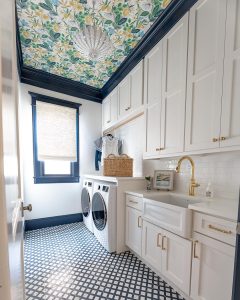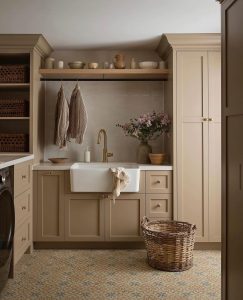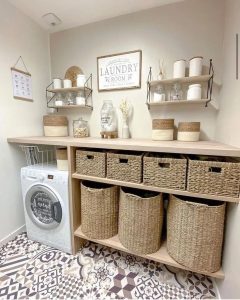How to Design the Perfect Laundry Room Layout for Your Home is a practical guide to help you fall in love with a space that often gets overlooked.
Let’s be real, laundry has a way of piling up no matter how often we tackle it. But the space where we do it? That space can still be beautiful, calm, and designed with care.
A well-designed layout isn’t about having the biggest room or the trendiest tiles. It’s about understanding how your family lives and finding a setup that makes daily tasks feel smoother. It’s about blending beauty and utility in a way that invites you in. Even if it’s just to fold towels or sort socks.
Whether you’re dealing with a tight space or finally planning your dream layout, this guide will walk you through it all. We’ll cover practical layouts, helpful zones, and styling tips to help you feel inspired by even the smallest details.
Why a Thoughtful Laundry Room Layout Matters
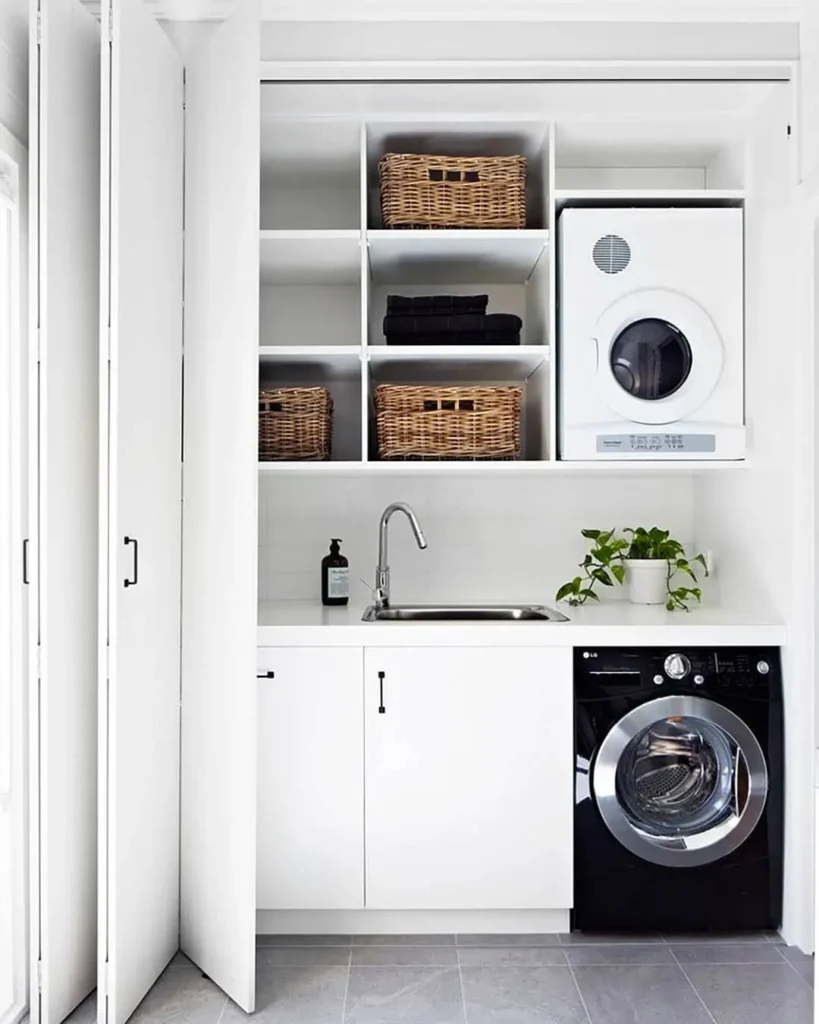
Designing a laundry room may not seem like a big decision at first. But the layout you choose will shape how the space works for you day after day.
When your layout flows well, the whole process—from washing to folding—feels easier. You spend less time hunting for supplies or shifting laundry piles. Instead, everything has a place, and everything feels intentional.
The Role of Functionality and Flow
Good design isn’t always about looks. It’s about how well a space serves the people who use it.
Think about your routine. You gather dirty laundry, load the washer, transfer clothes to the dryer, and then fold or hang them. If those steps happen in a natural order—without backtracking or bumping into clutter—you’ve already won half the battle.
A functional laundry room layout places the washer and dryer close together. It also includes a surface for folding, storage for supplies, and ideally, a spot to hang clothes as they dry. The best layouts let you move through the space with ease, saving time and frustration.
Common Laundry Room Mistakes to Avoid
When designing a layout, it’s easy to get caught up in the finishes and forget the basics. But some of the most common design issues are simple to prevent.
- Not enough counter space. Folding laundry on the washer or dryer works in a pinch, but it’s not ideal. A dedicated folding station can make the task more enjoyable—especially if you’re working with a small space. Here’s a guide on how to easily add a folding station to your small laundry room for ideas that work even when square footage is limited.
- Cluttered floors. Hampers, baskets, and cleaning supplies often get piled in corners. This creates stress and slows you down. Built-in storage and designated zones help keep things clear.
- Poor lighting. If the space feels dark, it can feel like a chore just walking in. Bright, layered lighting makes a big difference, especially in rooms with no windows.
- Ignoring ventilation. Washers and dryers generate heat and moisture. Without good airflow, your laundry room can feel stuffy—and sometimes even smell musty.
When your layout avoids these pitfalls and supports the natural flow of your routine, the space starts working for you in all the right ways. And once that’s in place, it becomes much easier to add the cozy, collected touches that bring it to life.
Assessing Your Space and Needs
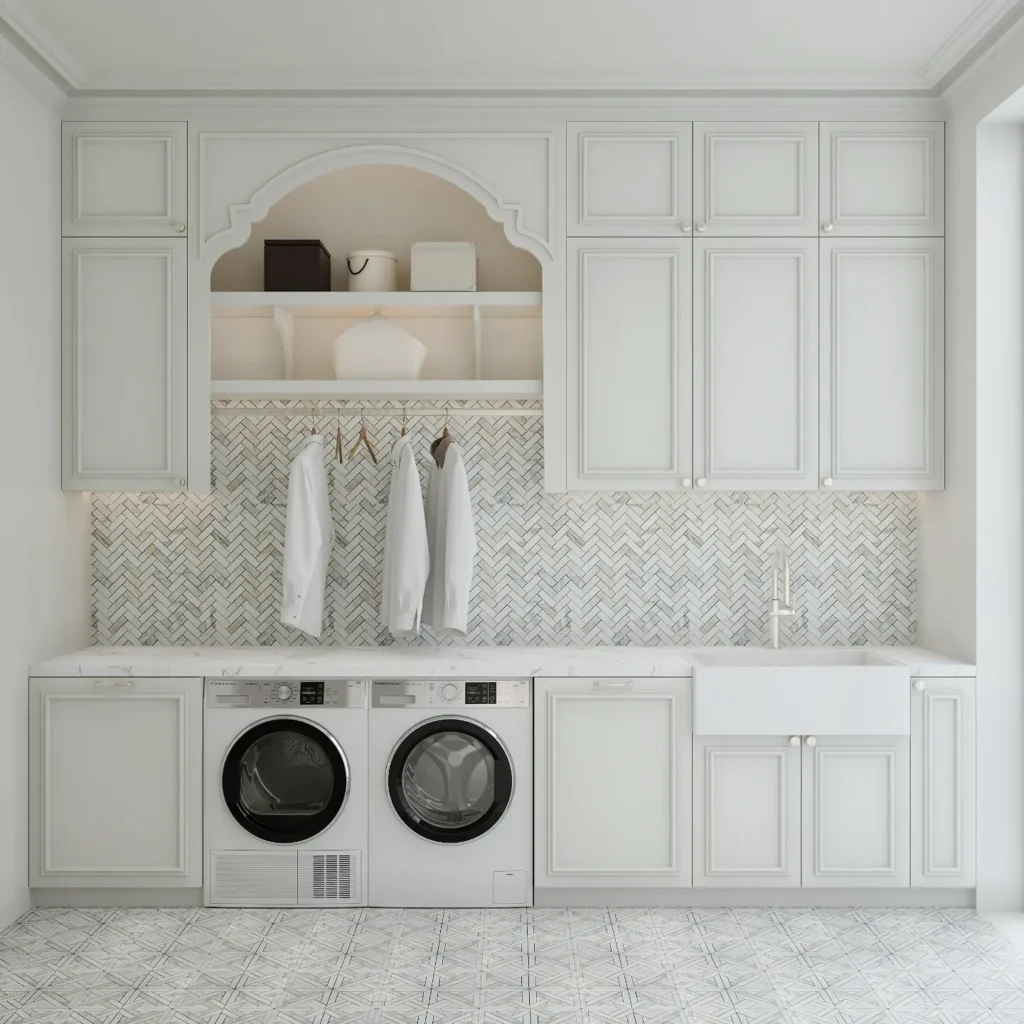
Before you dive into layout options, take a good look at the space you have. Every home is different. What works beautifully in one room may not make sense in another. That’s why starting with what’s real—your actual space, your routine, and your family’s needs—is the key to getting it right.
Laundry Room Dimensions and Appliance Requirements
Size isn’t everything, but it definitely matters. Think about how much room your appliances need—not just to fit, but to function.
Front-loading machines, for instance, need door clearance and space to move laundry baskets in and out. Stackable washers and dryers save space, but they need height and stable flooring. Side-by-side units offer more surface area on top, but they take up more room. If you’re considering this type of setup, you might find it helpful to read about everything you need to know before buying a stackable washer and dryer.
Also, keep walkways in mind. You’ll want at least three feet of clearance in front of machines and around folding areas so the space never feels cramped.
Choosing the Right Location in Your Home
Your laundry area doesn’t need to be tucked away in a basement. In fact, where you place it can influence how often and how comfortably you use it.
- Main-floor laundry rooms are great for busy families who want laundry to be close to the heart of the home.
- Basement setups often offer more space but can feel disconnected.
- Hallway or closet laundry areas are smart for small homes and apartments.
- Second-floor laundry rooms near bedrooms cut down on back-and-forth trips.
There’s no one perfect spot. It’s about balance—finding the location that makes laundry easier, not harder. For help figuring out if your space is the right size, check out this post on laundry room dimensions and how big your laundry space should be.
At this stage, it’s helpful to sketch your room on paper. Note outlets, water lines, and windows. Identify awkward corners or walls that jut out. This gives you a real sense of what you’re working with before picking your layout.
Popular Laundry Room Layouts to Consider
The layout you choose should match how you use the space. Some homes have large, dedicated laundry rooms. Others make use of a hallway nook or converted closet. No matter the size, the right layout can help you create a space that’s practical, comfortable, and even beautiful.
Here are a few of the most popular laundry room layouts and what makes them work.
Galley (Long and Narrow) Laundry Room Layout
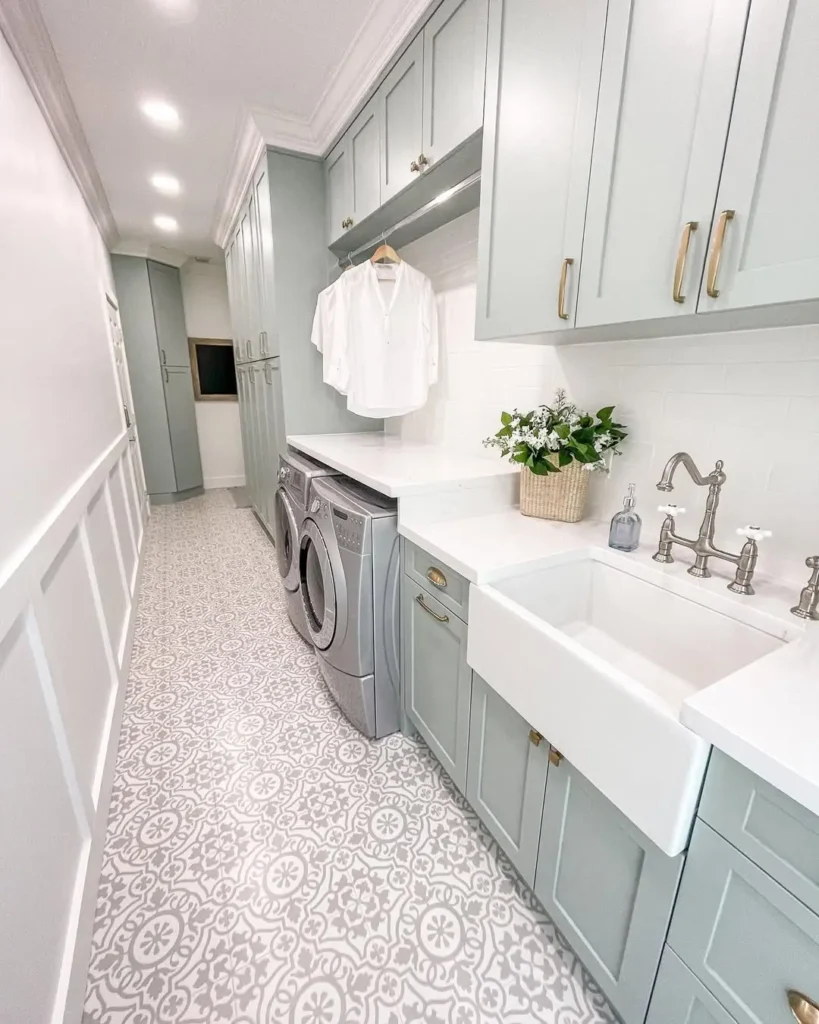
This setup is ideal for small or narrow rooms, especially if you’re working with a space that’s more hallway than room. Appliances and cabinetry run along one or both walls, creating a streamlined work zone.
When working with a narrow footprint, you’ll want to focus on visual clarity and storage solutions that don’t take up floor space. Wall-mounted shelves, sliding doors, and stackable units are your best friends here.
If this sounds like your setup, take a look at these smart space-saving ideas in how to maximize space in your long narrow laundry room. It’s filled with clever layout tips and simple design changes that make a big impact.
L-Shaped and U-Shaped Laundry Room Layouts
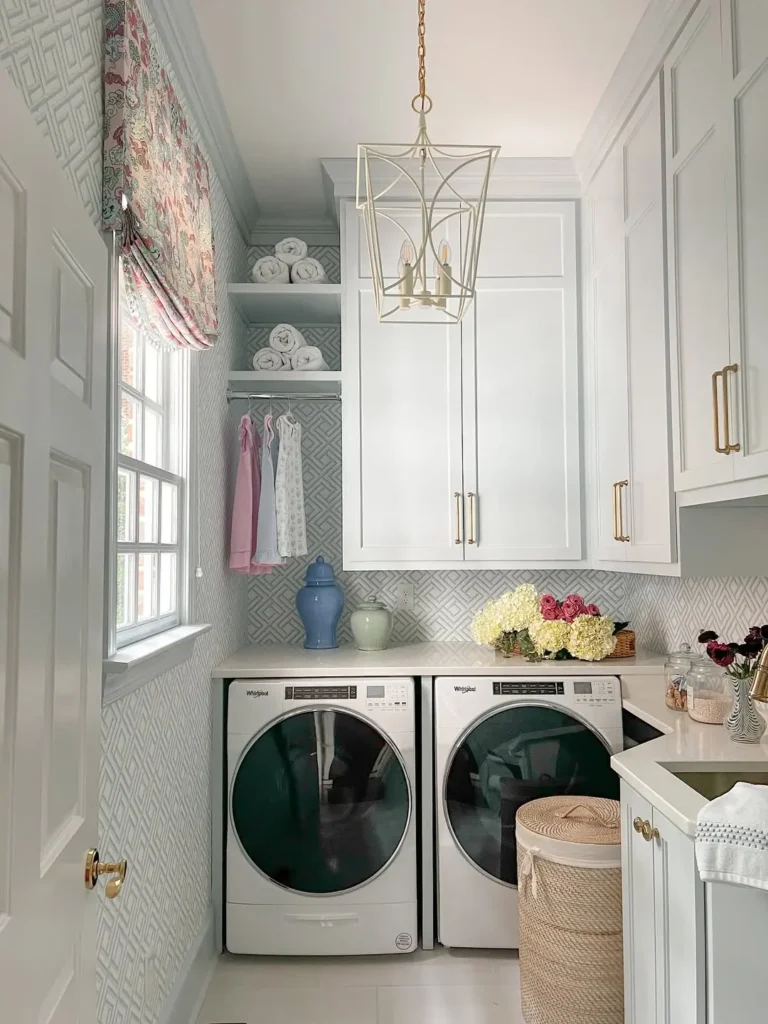
These layouts are a great option if your laundry room is tucked into a corner or has a little more square footage to work with.
An L-shaped layout places your appliances on one wall and a folding or storage area on the adjoining wall. It’s compact, yet efficient.
A U-shaped layout wraps around three walls, giving you room for appliances, a folding station, and closed storage. This layout is great for families or anyone who wants space to sort, hang, and fold in one place.
If you have the room, a U-shaped design can really elevate the space. It feels more like a working utility room than a pass-through zone.
Laundry Room + Mudroom Combo Layout
One of the best ways to maximize your space is to combine functions. Laundry rooms that double as mudrooms are perfect for busy households. These rooms become the catchall for dirty shoes, wet towels, pet gear, and laundry—all in one spot.
This layout works well with built-in storage, hooks, benches, and durable flooring. You’ll want to separate zones so the space stays organized and welcoming, even on the busiest days.
For tips on how to blend style and storage, explore this guide on how to design a stylish laundry-mudroom combo that works. If you’re still in the planning phase, you might also appreciate your ultimate functional and stylish mudroom guide for inspiration and layout ideas.
The key with combo spaces is balance. You want the laundry zone to stay functional without crowding out everything else. Closed cabinets, woven bins, and vertical storage help create a clean look with plenty of hidden storage.
Must-Have Zones in a Perfect Laundry Room Layout
A well-designed laundry room isn’t just about where your washer and dryer go. It’s about how the space supports your routine. Creating designated zones for each task—washing, drying, folding, storing—makes every step feel smoother and more intentional.
Let’s walk through the zones every great laundry room should have.
Washing and Drying Zone
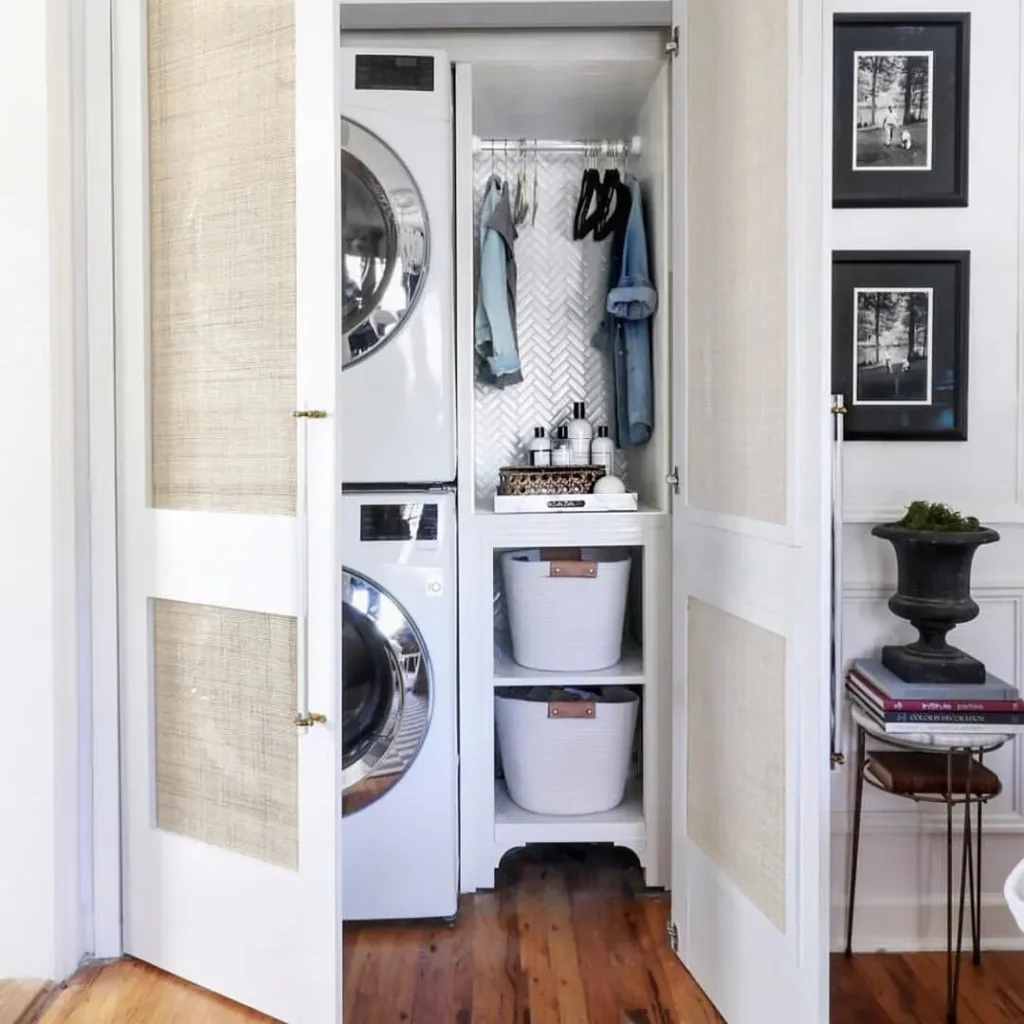
This is your foundation. The washer and dryer should be placed where you can access them easily, with room to open doors and move around.
If you’re short on space, stackable units can be a great solution. They free up floor space and allow room for vertical storage. For helpful advice, check out everything you need to know before buying a stackable washer and dryer to see if this setup is right for you.
Place your washing supplies nearby. A small cabinet or open shelf above or beside the machines keeps detergent and softener close at hand without creating clutter.
Folding and Sorting Station
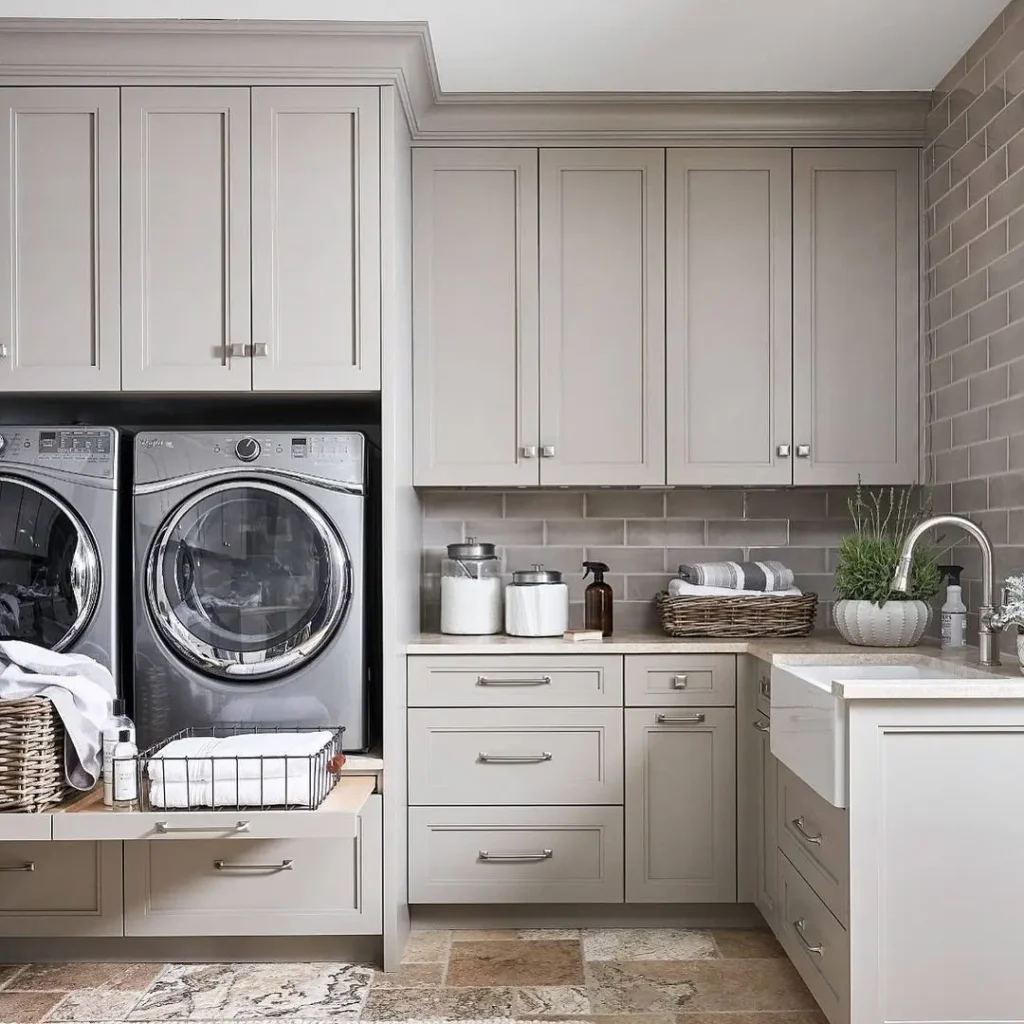
No more folding on the bed or kitchen table. A designated surface makes laundry feel less scattered and more manageable. This could be a long countertop over front-loading machines or a dedicated folding table.
Short on space? You can install a wall-mounted table or fold-down surface. These space-saving features are ideal for small rooms. For ideas, visit how to easily add a folding station to your small laundry room.
Baskets, bins, or hampers under the counter make it easy to sort by color, owner, or wash type.
Drying and Hanging Zone
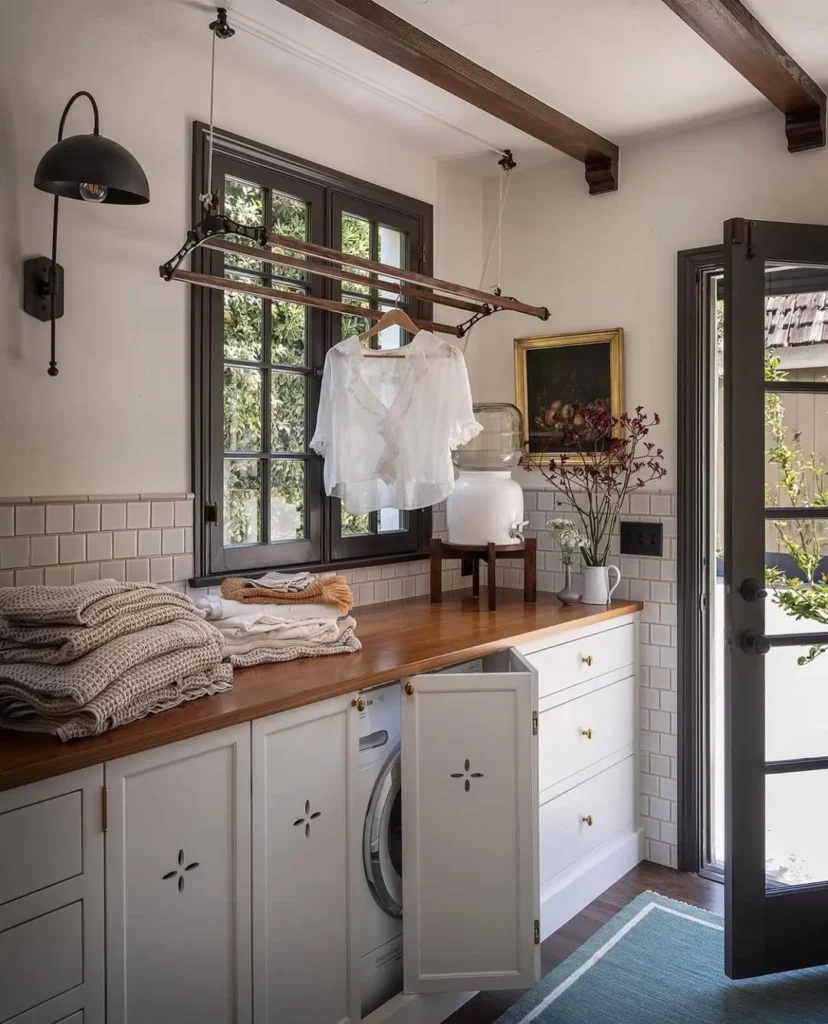
Some items just can’t go in the dryer. That’s why a dedicated drying space is essential. This can be as simple as a retractable drying rack, a mounted rod, or a freestanding unit that fits into a corner.
Choose a setup that suits your space and routine. For practical options, take a look at how to choose a drying rack for your small laundry room.
Wall-mounted hooks or a slim tension rod can also work well if you’re tight on square footage.
Storage Zone
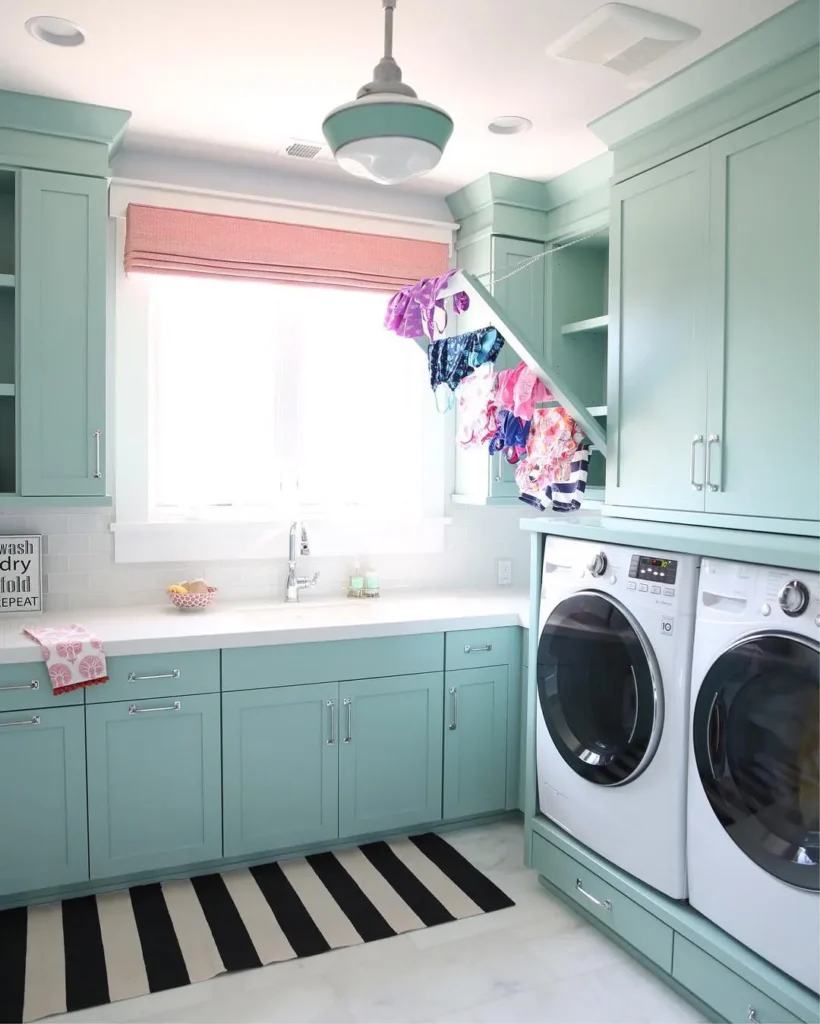
A tidy laundry room starts with smart storage. This is where everything from extra towels to pet supplies finds its home.
Overhead cabinets, floating shelves, or tall storage units make the most of vertical space. Label bins and baskets to keep small items in order. For an expert breakdown of what works best, see the best materials for laundry room cabinets to choose finishes that hold up well and look great.
Closed storage is especially helpful if your laundry room is part of a high-traffic area. It keeps things looking neat, even on your busiest days.
Laundry Room Decor Tips to Enhance Your Layout
Once your layout and zones are in place, it’s time to add warmth and style. Even the most functional laundry room deserves to feel beautiful. The right decor can elevate the space, make chores more enjoyable, and help the room feel like a natural extension of your home.
Color Schemes and Finishes
Color has the power to shift a mood. Light, airy tones make small rooms feel bigger. Deep, rich shades can add coziness and depth. For example, a moody green or navy creates a sense of calm, especially when paired with brass hardware or warm wood tones.
If you’re looking for inspiration beyond the standard white-and-gray palette, check out ideas in how to create a moody laundry room. You’ll find ways to use bold hues without overwhelming the space.
Finishes matter, too. Matte black fixtures feel modern. Aged brass adds vintage charm. Choose hardware and light fixtures that match the overall tone of your home.
Lighting and Flooring Considerations
Good lighting turns a hard-working space into a bright, welcoming one. Natural light is best, but if your laundry room is tucked away, use layered lighting. Combine ceiling lights, under-cabinet LEDs, and task lamps to brighten your work areas.
For flooring, think practical but pretty. You want something water-resistant and easy to clean—like porcelain tile, vinyl planks, or sealed concrete. Herringbone or checkerboard patterns can bring in character without sacrificing durability.
A small rug or washable mat near the machines adds comfort underfoot and a splash of personality.
Personal Touches and Styling
This is the fun part. Just like every other room in your home, your laundry room can tell your story.
Hang framed art or family photos. Use glass jars or labeled canisters for detergent and clothespins. Display a favorite quote on a wooden sign or add a vintage basket that’s both pretty and practical.
If you need more ideas, browse through 10 laundry room decor ideas that make you love doing laundry. It’s filled with styling tips to bring charm and character into even the smallest corners.
You don’t need to spend a lot to make the space feel personal. Start with one or two pieces that you love and build from there. When your laundry room reflects your taste, it feels like home—even when you’re folding towels.
Tips for Small Laundry Room Layouts
Small laundry rooms come with their own set of challenges—but also a lot of potential. With smart planning and a few creative tricks, you can design a compact space that feels open, organized, and easy to use.
Smart Space-Saving Solutions
The key is to make every inch work harder. Start by looking up—vertical space is often underused.
Install wall-mounted shelves above your washer and dryer for storing supplies. Use over-the-door racks for cleaning products or lost-and-found items. Slide a narrow rolling cart between machines for detergents and dryer sheets.
If you’re tight on floor space, stackable units are a lifesaver. To help you get the most from your setup, check out how to maximize small laundry room storage space. It’s full of ideas that don’t require knocking down walls.
Pocket doors are another smart option. They save room where a swinging door might block access or make the space feel cramped.
Multi-functional Furniture and Vertical Storage
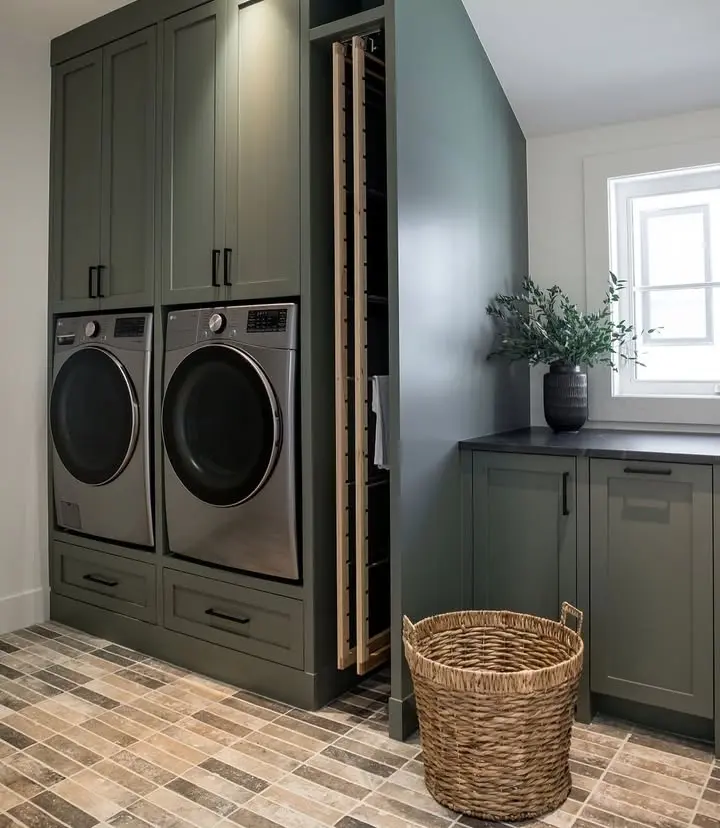
Think of furniture that does double duty. A bench with hidden storage can serve as a seat and a place to stash linens or baskets. A fold-down ironing board can be tucked into the wall and hidden when not in use.
Use vertical space for more than just shelves. Pegboards, hooks, or hanging baskets can keep essentials in reach without cluttering the counter.
Ceiling-mounted drying racks or retractable lines offer a great solution when floor space is limited. If you have a top-loading washer, mount them high enough to avoid interference.
With the right setup, even the smallest laundry room can feel roomy, intentional, and beautifully styled. You don’t need more space—you just need the right solutions.
Combining Style and Utility in Your Laundry Room Layout
The best laundry rooms strike a balance between practical and personal. Yes, they need to work hard—but they can look good while doing it. When your layout blends everyday function with your unique style, the space becomes more than just a chore zone. It becomes a place you enjoy being in.
Match Your Style—Modern, Farmhouse, Coastal, or Moody
Start by identifying the style that fits your home best. Then, pull elements of that style into your laundry room layout.
If you love a clean and current look, you might be drawn to how to create a sleek and stylish modern laundry room. Think matte finishes, neutral tones, and integrated storage.
Prefer something warm and cozy? Soft woods, shaker cabinets, and vintage-inspired fixtures can bring farmhouse charm. For a complete guide, check out how to create a modern farmhouse laundry room.
If your style leans breezy and relaxed, coastal touches like whitewashed finishes, woven textures, and ocean-inspired hues may be the way to go. For inspiration, take a peek at how to style a coastal-inspired laundry room.
And if drama is more your speed, dark cabinetry, brass details, and moody colors can make your laundry room feel like a design-forward retreat.
Custom Features to Enhance Everyday Use
Once your style is set, look for ways to build in convenience. These small upgrades make a big difference in daily use.
- Pull-out hampers or baskets under counters help keep laundry sorted.
- Slide-out shelves between machines add extra storage without crowding the space.
- Built-in ironing stations, hidden trash bins, and soft-close cabinets elevate functionality.
Open shelves are a great way to display decor, but mix in closed storage to hide the not-so-pretty things. Every feature should serve a purpose, but it can still look good doing it.
When style and utility come together, your laundry room becomes more than a functional spot—it becomes a space that truly works for your home and reflects your story.
Expert Tips to Plan and Execute Your Laundry Room Design
Designing a laundry room doesn’t have to feel overwhelming. With a bit of planning and a few well-placed upgrades, you can turn even the most basic setup into a space that feels polished and practical.
Here are some helpful expert tips to guide your process from start to finish.
Budgeting for Your Remodel
Before you shop for tile or cabinets, set a realistic budget. Laundry room upgrades can vary widely in cost depending on materials, layout changes, and whether you DIY or hire help.
Here’s a good starting point:
- DIY Updates: Paint, lighting, shelving, and decor can often be tackled for under $1,000.
- Mid-Range Remodel: Adding cabinetry, counters, or stackable units may range from $2,000–$5,000.
- Full Overhaul: A complete redesign with plumbing or electrical work could cost $6,000 or more.
Break your budget into categories: appliances, cabinetry, surfaces, lighting, and styling. This helps you prioritize what matters most. For example, investing in smart storage may bring more long-term value than high-end tile.
And don’t forget to leave room for surprises—there’s almost always one.
Planning for Future Flexibility
Think beyond your current needs. Design choices that work now should still serve you well down the road.
For instance:
- Choose modular cabinets or shelving systems that can be rearranged.
- Leave space for larger appliances if you plan to upgrade in a few years.
- Add extra outlets or lighting now, even if you don’t use them yet.
If your laundry room doubles as a mudroom, home hub, or pet-washing station, build in flexibility. A bench with storage today can become a folding surface or workspace later.
Finally, don’t feel like you have to finish everything at once. Start with the essentials, then layer in details over time. Many of the most loved spaces come together slowly—and intentionally.
Conclusion
Designing the perfect laundry room layout for your home isn’t about chasing perfection. It’s about creating a space that supports your rhythm, reflects your style, and makes everyday tasks feel just a little easier.
Start with the layout, focus on function, then layer in the charm that makes the room feel like yours. Whether you’re working with a full remodel or just updating a few key features, your laundry room can become a space you genuinely enjoy.
For even more ideas on blending style and function, check out your ultimate guide to designing a stylish and functional laundry room.
So take your time, trust your instincts, and remember—you’re not just folding clothes. You’re designing a home that works for the people you love most.
Frequently Asked Questions: Laundry Room Layout
What is the ideal layout for a small laundry room?
The best layout for a small laundry room is one that maximizes vertical space and keeps your workflow simple. Galley-style layouts, stackable washer and dryer units, and fold-down work surfaces help make the most of tight spaces. Use open shelves and slim storage to avoid clutter.
For more compact solutions, visit how to maximize small laundry room storage space.
How can I make my laundry room more functional without doing a full renovation?
Start with the small things that make a big impact. Add shelves above your machines, switch out baskets for labeled bins, or install hooks for hanging items. Updating your lighting or painting the walls can also refresh the space without major work.
Simple changes like these are covered in 10 laundry room decor ideas that make you love doing laundry.
Can I fit a laundry room into a hallway or closet?
Absolutely. Many homeowners turn closets, pantries, or hallways into efficient laundry zones. The key is choosing compact appliances, like stackables or all-in-one washer-dryer units, and using vertical storage to keep things tidy.
What’s the best flooring for a laundry room?
Choose flooring that’s durable, water-resistant, and easy to clean. Porcelain tile, vinyl plank, and sealed concrete are all great options. If you want to add comfort, place a washable rug or mat near the machines for a soft spot underfoot.
How do I choose the right decor style for my laundry room?
Start with your home’s existing style, then carry that into your laundry space. Whether you lean modern, farmhouse, coastal, or moody, choose a few elements—like cabinet finishes, lighting, or wall color—that reflect your taste.
For specific inspiration, explore posts like how to create a sleek and stylish modern laundry room or how to create a modern farmhouse laundry room.
Are there any downsides to having the laundry room on the second floor?
Second-floor laundry rooms are super convenient, especially near bedrooms, but there are a few things to keep in mind. Vibration and noise can travel through the floor, and there’s always a risk of water leaks. To stay ahead of issues, use anti-vibration mats, install a drain pan, and check that the floor can support the weight. Good ventilation is also key—especially for dryers.
Need to get back to this post for reference? Save the pin to your laundry room board for later!


